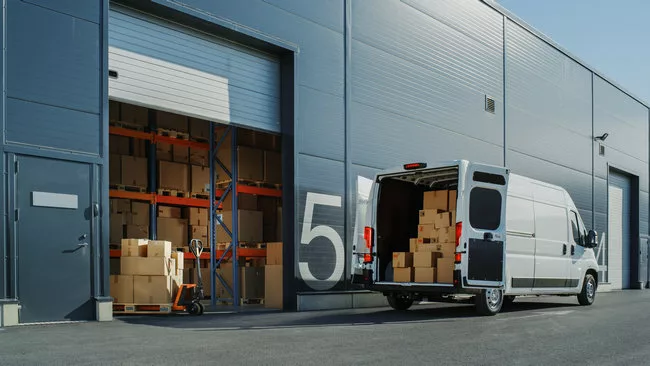From foreign customers purchasing products from Chinese manufacturers to multinational enterprises seeking to operate in China, fast and efficient supply chains are always a critical factor of their operation. The most common practice is cooperating with a single freight forwarder for the international door-to-door shipping service.
This guide from Luckystar Logistics aims to help you gain a better understanding of how door-to-door delivery works, where it’s most valuable, and what the cost factors are. Read on and you will learn all the intricacies you need as a customer!
Table of Contents
- What Door-to-Door International Shipping Means
- When to Use Door-to-Door Shipping Service
- The Step By Step Logistics of Door to Door Shipping
- Logistic Concepts & Incoterms You Must Know
- How Quotes Are Built and Ways to Save on Expense
- Choose the Right Provider for Door-To-Door Freight
- Frequently Asked Questions

What Door-to-Door International Shipping Means
By definition, international door-to-door delivery boasts multiple prominent features: One freight forwarder will be responsible for your cargo from start to finish. It requires only one contract and one point of contact, ensuring end-to-end accountability; the goods are directly transported from pickup at the shipper’s address to delivery at the consignee’s door.
This shipping option differs from port-to-port or airport-to-airport services, where the shipper or consignee must arrange pre‑carriage, on‑carriage, and customs. No more dealing directly with multiple carriers, brokers, and authorities. Instead, a single provider orchestrates the handoffs, and takes responsibility for exceptions. With this delivery option, the provider aligns each link so the shipment keeps moving without the buyer or seller stepping in.
When to Use Door-to-Door Shipping Service
There is a misconception that door to door shipping is a highly personalized delivery service that only aims for individual customers on e-commerce websites. As a matter of fact, this shipping process is suitable for many applications and has an entire streamlined process set up by logistics companies.

The Step By Step Logistics of Door to Door Shipping
Door to door shipping follows both well-established industrial norms and customized service principles, and here is a detailed example of how freight forwarders carry out door-to-door delivery services.
1) Quote and booking
First, the shipper (customer) shares origin and destination addresses, commodity description and HS code, weight and dimensions, value, and required delivery date. Then, the provider (freight forwarder) proposes a route by air, sea, courier, or intermodal transport, along with an estimated transit time and a price determined by negotiation. After both parties have reached an agreement, the logistic flow proceeds.
2) Pickup cargo and origin handling
The carrier starts by collecting the goods at the shipper’s door, verifies packaging and labeling, and applies any export marks or security screening. If export packaging or palletization is needed, it’s completed at the origin facility. Proof of pickup and a handover to the origin terminal follow.
3) Export customs clearance
The provider prepares and files export documentation, a commercial invoice, a packing list, and a transport document. Licenses or certificates are obtained if required. Once cleared, the cargo is released for carriage.
5) Import customs clearance
At the destination, the provider or its broker files the import entry, confirms classification and valuation, and settles duties/taxes accordingly. After custom inspections, the goods will be released from the customs supervised warehouse for the final part of the process.
6) Final-mile delivery
After clearance, the local delivery partner completes the last mile through road freight or rail system. Appointments, tail‑lift trucks, or white‑glove services can be arranged.
Logistic Concepts & Incoterms You Must Know
| Concepts/Incoterms | Definition / Key Details |
| Commercial Invoice | Describes the goods, price, currency, terms of sale, and the parties involved in the transaction. |
| Packing List | Itemizes the contents, weights, and dimensions of each package in the shipment. |
| Transport Document | The contract of carriage; varies by mode (e.g., Air Waybill for air, Bill of Lading for sea, CMR for road). |
| Certificate of Origin | Reduces or eliminates duties under applicable trade agreements. |
| HS Codes | Standardized codes that determine duty rates and admissibility. Misclassification can lead to fines or seizure. |
| Valuation | The declared value for customs, which must include assists, royalties, and freight as required by the destination country’s law. |
| Importer of Record (IOR) | The entity legally responsible for all customs compliance. In DDP, the seller may act as IOR via an affiliate, but this is not permitted in all countries. |
| DDP (Delivered Duty Paid) | Seller covers all costs and risks to the buyer’s door, including duties and taxes. Requires a robust compliance setup from the seller. |
| DAP (Delivered At Place) | Seller delivers the goods to a named place; the buyer is responsible for paying all import duties and taxes. Reduces the seller’s tax burden. |

Shipping Methods and When to Use Each
Choosing an international shipping method is a fundamental logistics decision that requires balancing key factors such as speed, cost, reliability, and the specific profile of your cargo. A capable door-to-door service will clearly present a range of options, including hybrid intermodal routes, to help shippers find the optimal balance for their needs.
Air freight is typically the preferred solution for urgent or high-value shipments that are small to medium in size. Its primary characteristics include:
- Fast transit times, 2 to 6 days door-to-door shipping under favorable conditions.
- Higher cost compared to other modes.
- Highly predictable and frequent schedules.
For large, heavy, or non-urgent consignments, ocean freight is the most cost-effective choice, available in Full Container Load (FCL) or Less than Container Load (LCL) options.
- Lowest cost per kilogram.
- Slower transit times, often ranging from 3 to 7 or more weeks.
- Requires careful advance planning and scheduling.
When shipping parcels, samples, or documents, courier and express services offer a highly integrated solution.
- The fastest option for small parcels.
- Comprehensive, all-inclusive tracking and management.
- Simplified customs with Delivered Duty Paid (DDP) or Delivered at Place (DAP) options.
For regional moves between land-connected markets, road and rail transport provide a reliable and competitive alternative.
- Competitive transit times for regional distances.
- Generally stable and predictable costs.
- Customs formalities still apply for cross-border shipments.
Several rules of thumb can guide the decision-making process. First, if your delivery window is measured in days, you should consider air or express services; if it is measured in weeks and the shipment is heavy, ocean freight usually wins on cost.
Second, it is crucial to remember that volumetric weight applies in air and courier networks, meaning bulky but light items are charged as if they were heavier, so smart packaging can shift the economics.
Finally, LCL consolidations help spread the cost of a container for smaller ocean shipments, though they add handling and a few days of consolidation time to the transit. For complex supply chains, intermodal plans that use air for a critical subset of goods and sea for the balance can be an effective way to balance risk and budget.
How Quotes Are Built and Ways to Save on Expense
A door-to-door quote is built from a handful of drivers: shipment characteristics, route, service speed, and extras.
What drives cost
- Weight & Dimensions: Air freight uses actual or dimensional weight (whichever is higher); ocean freight uses per-container or per-cubic-meter rates.
- Origin & Destination: Remote areas add extra costs; some countries have mandatory security or customs fees.
- Mode & Speed: Time-definite air costs more than standard; direct ocean sailings cost more than transshipments.
- Accessorials: Fees for special delivery needs (e.g., residential, liftgate, appointment, inside delivery, waiting time).
- Surcharges: Variable fees like peak season, fuel (bunker), currency adjustment, and congestion.
- Value-Adds: Special handling for insurance, special packaging, temperature control, and dangerous goods.
Ways to save without adding risk
- Choose a slower mode when timelines allow (ocean vs air: economy vs express).
- Consolidate orders to reach FCL thresholds or batch weekly parcel pickups.
- Engineer packaging to reduce dimensional weight and minimize oversize fees.
- Provide exact data (weights, dimensions, and HS codes) to avoid re‑rates and customs holds.
- Leverage trade agreements with correct origin documentation.
- Align Incoterms with customer expectations to avoid surprise D&T bills and redelivery.
You should also ask providers for a landed‑cost breakdown of your international shipment to review the base freight, brokerage, duties/taxes, and accessorials, so internal teams can compare apples to apples.
Choose the Right Provider for Door-To-Door Freight
Selecting an effective door-to-door freight provider requires a match between a shipper’s specific needs and the carrier’s capabilities.
A capable door-to-door freight forwarder should demonstrate established strength on the required shipping lanes, and provide reliable customs brokerage. Its service models should have operational transparency on clear pricing, detailed shipment plans and negotiation mechanisms.
Ready to partner with a provider that meets all these standards?
Luckystar combines 20+ years of expertise with competitive pricing to provide you with a reliable, end-to-end solution for shipping to and from China, the US, Canada, and Europe. Contact us to learn more!
